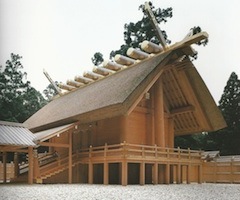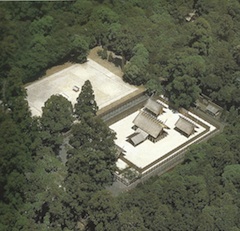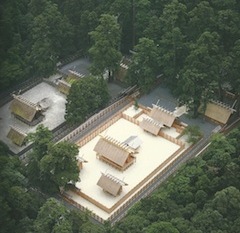Ise Jingu: The Grand Shrine at Ise
 |
 |
 |
The Naiku shrine of the goddess Amaterasu-omikami |
The grand shrine at Ise is known as the spiritual home of the Japanese people. Dedicated to the goddess Amaterasu-omikami it is said that the location was found 2,000 years ago by Princess Yamatohime-no-mikoto, daughter of the Emperor Suinin who was directed to the spot by the goddess herself. A second principal shrine at Ise is known as Geku and is dedicated to the god Toyouke Omikami.
For centuries the high priestess of the Naiku shrine was always a member of the imperial family, which traces its descent from the goddess Amaterasu-omikami. This intertwining of spiritual significance with earthly power makes the shrine central to Japanese cultural history.
In total the Ise complex houses 125 different shrines spread across an area the size of Paris. According to some estimates as many as 8 million pilgrims visit the site each year, with one million coming on New Year's Day alone. Over 1500 rituals are performed at Ise throughout the year.
 |
 |
 |
The vacant site, covered in white stones and with only a small shed on it, is where the next renewal will take place |
The site is self-sufficient in producing sacrificial food, ceremonial hemp and silk clothing and the wood for building shrines. By tradition each wooden shrine is replaced every 20 years, a new and identical building being constructed on a vacant site next to the existing shrine.
In the case of the grand shrine this requires about 8,500 cubic metres of wood, and in 1922 a 200-year tree planting project was begun at Ise. The first wood from this programme was used in the 62nd renewal of the shrine which has just been completed. Wood from the old shrine is recycled to help renew other, lesser shrines: the last time this was done some 169 shrines benefited from the recycled wood.
 |
 |
 |
By the time of the Shikinen Sengu ceremony a complete new shrine has been built adjacent to the existing one. |
The renewal ceremony, known as Shikinen Sengu, is a hugely significant ritual in which the goddess is invited to come to live in the new shrine building, and some 800 beautiful hand-made artefacts, including clothes, weapons, ornaments and musical instruments are donated to make the new household.
|

